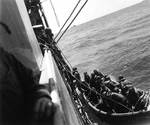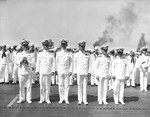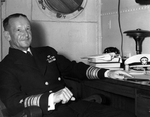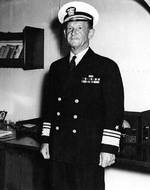Frank Fletcher
| Surname | Fletcher |
| Given Name | Frank |
| Born | 29 Apr 1885 |
| Died | 25 Apr 1973 |
| Country | United States |
| Category | Military-Sea |
| Gender | Male |
Contributor: C. Peter Chen
ww2dbaseFrank Jack Fletcher was born in Marshalltown, Iowa, United States as the nephew of American admiral Frank Friday Fletcher. He graduated from the Naval Academy at Annapolis on 12 Feb 1906 and spent the next two years at sea before he was commissioned a junior officer rank of ensign. After some time spent aboard ships of various classes, he was given commission of the destroyer Dale in Apr 1910. In Apr 1914, Lieutenant Fletcher served aboard the battleship Florida at Vera Cruz, Mexico, for which operation he received the Medal of Honor. His citation was as follows:
ww2dbaseAfter some time spent with the Atlantic Fleet and the Naval Academy, Fletcher was transferred back on combat duty when the United States entered WW1. He filled roles of various capacities during the war, and was awarded the Navy Cross.
ww2dbaseDuring the inter-war years, Fletcher served with the Asiatic Station for several years, and completed the Senior Course at the Naval War College in Newport, Connecticut, in Jun 1930. In Aug 1931, he became Chief of Staff to the Commander in Chief of the Atlantic Fleet. In summer 1933 he was transferred to the Office of the Chief of Naval Operations. Later that year he was promoted to the position of Aide to the Secretary of the Navy. In Jun 1936, he returned to the sea, taking command of the battleship New Mexico. After 13 months ashore as the Assistant Chief of Bureau of Navigation in 1938 and 1939, he returned to sea command again in Sep 1939 and became a cruiser division commander.
ww2dbaseWhen the Pacific War broke out, Fletcher was assigned to command an American-Australian joint task force, with his flag on the carrier Yorktown. His task force first guarded South Pacific islands against further Japanese advance, then raided Japanese bases across the southern and central Pacific. He played critical roles in the outcome of the Battle of Coral Sea and the subsequent Battle of Midway, two early major battles in the Pacific for the Americans and two of the first major carrier engagements of the war. Although both battles resulted in American victories, Fletcher was criticized for the way he handled the situation when Yorktown was disabled. He transferred his flag to the cruiser Astoria, and dedicated himself in the attempt to controlling the damage and rescue the survivor of the carrier. However, given he was the commander of a task force, he was criticized by Admiral Ernest King for lacking aggressiveness, for he could have easily used one of Astoria's aircraft to reach another American carrier and continue to conduct offensive operations against remaining Japanese forces in the area. Instead, Fletcher's transfer to Astoria left Raymond Spruance without a clue that he had succeeded command of the task force, thus wasting time as the American task force operated without a leader.
ww2dbaseSoon after Battle of Midway, Fletcher's forces invaded the Japanese strongholds in the Solomons Islands. Although his ships allowed the United States Marines to land on Guadalcanal, he was not a popular figure among the Marines. After disappointing the Marines on Wake Island in the opening days of the Pacific War due to a lack of fuel (some records indicated he had enough fuel to make the trip and back), during the Guadalcanal Campaign he again abandoned the Marines, this time in the face of potential Japanese air attacks in addition to a fuel shortage. Fletcher was "always fueling", commented historian Samuel Eliot Morison. Fletcher's departure resulted in the bloody Battle of Savo Island where the American surface forces suffered heavy losses. Marine Corps general Alexander Vandegrift accused Fletcher of "running away" as the Marines became stranded on Guadalcanal with barely adequate food and other supplies to fight the Japanese. From Nov 1942 and on, he was placed in positions of increasing responsibilities, with the pinnacle in 1943 when he oversaw the entire northern Pacific area.
ww2dbaseAfter the war, Fletcher's forces occupied northern Japan. Then he became the Chairman of the General Board. He retired from the Navy in May 1947. He passed away in 1973 at Bethesda Naval Hospital in Bethesda, Maryland, United States. He rests in peace at the Arlington National Cemetery in Arlington, Virginia.
ww2dbaseSources: Goodbye Darkness, Midway Dauntless Victory, Wikipedia.
Last Major Revision: Aug 2008
Frank Fletcher Interactive Map
Photographs
 |  |  |  |
Frank Fletcher Timeline
| 29 Apr 1885 | Frank Fletcher was born. |
| 6 Feb 1942 | Task Force 17 under the command of Rear Admiral Jack Fletcher and consisting of USS Yorktown, USS Louisville, and USS St. Louis arrived at Pearl Harbor, US Territory of Hawaii. |
| 1 May 1942 | US Task Force 17 was established under command of Rear Admiral Frank Fletcher to operate in the Coral Sea. |
| 16 Jul 1942 | US Navy Vice Admiral Robert Ghormley named Vice Admiral Frank Fletcher the commanding officer of the Solomons Expeditionary Force. |
| 25 Apr 1973 | Frank Fletcher passed away. |
Please consider supporting us on Patreon. Even $1 per month will go a long way! Thank you. Please help us spread the word: Stay updated with WW2DB: |
Visitor Submitted Comments
1 May 2014 10:22:48 PM
I am startled to read, that the comments about admiral Frank Fletcher, are not up to date. Too much hear-say and not enough facts. Concerning the Wake relief action, he was ordered to abort the mission by his superior Admiral Pye. When he lost Yorktown at Midway, he handed over tactical command to Spruance by radio message. Concerning the Guadalcanal campaign, he withdrew indeed early, but the marines were warned in advance about this. He was most anxious to preserve his few carriers at all cost, knowing that the Japanese navy was still present in the area.
For me he was the American Admiral who held the line in these first 10 months of the war. He had to start from scratch to haul in victory at the battles of the Coral sea and at Midway. There was no other admiral who had combat experience at his level in September 1942. Those who came after him , learned from his experience and improved techniques. He did not give testimony to the Morison study about the Pacific war. So in his book his actions were judgded by others, being incorrect or only partial true.
Thankfully today, many sources reveal that the actions taken by Fletcher, were mostly correct and well thought. His actions did indeed change the turn of the war and this should be highlighted !
14 Aug 2019 05:26:57 PM
In my opinion, Fletcher deserves (for the most part) praise, not condemnation, for his actions up to Guad. As for his actions off Guad, I've read the revised (more accurate) history and still cannot approve.
25 Aug 2019 12:43:45 PM
May I append to that last comment: I certainly do NOT subscribe to the theory that Fletcher displayed any "yellow" (at least as far as his personal safety) off Guad. I think it was an understandable error in judgment, possibly informed by battle fatigue....
All visitor submitted comments are opinions of those making the submissions and do not reflect views of WW2DB.
» Battle of Coral Sea
» Battle of Midway and the Aleutian Islands
» Guadalcanal Campaign
» Solomon Islands Campaign
Ship(s) Served:
» New Mexico
» Yorktown (Yorktown-class)
- » 1,167 biographies
- » 337 events
- » 44,606 timeline entries
- » 1,243 ships
- » 350 aircraft models
- » 207 vehicle models
- » 376 weapon models
- » 123 historical documents
- » 261 facilities
- » 470 book reviews
- » 28,500 photos
- » 365 maps
Joachim von Ribbentrop, German Foreign Minister, Aug 1939
Please consider supporting us on Patreon. Even $1 a month will go a long way. Thank you!
Or, please support us by purchasing some WW2DB merchandise at TeeSpring, Thank you!
6 Jul 2008 12:04:01 AM
The comments on this site regarding Admiral Frank Fletcher are objectionable, at best, for a ‘web-site’ in the 21st Century, more so with the available historical records now available to even amateur historians. I am not attempting to insult those of this site, but I am clearly challenging the reprehensible statements made by this site regardless of what the Marines ‘think’.
I do appreciate the pictures posted throughout the site.
Respectfully